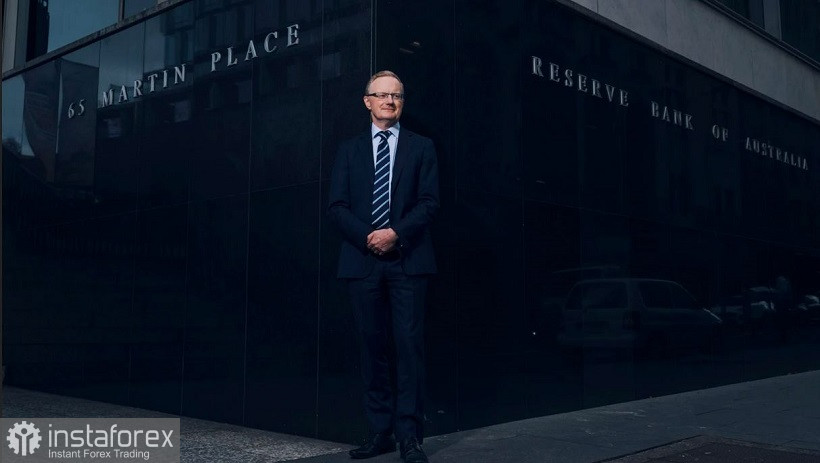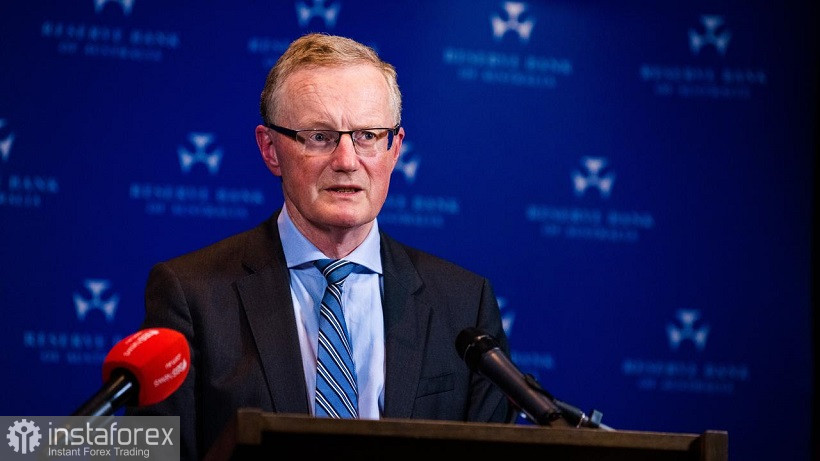The Australian dollar remains under pressure. The minutes of the Reserve Bank of Australia's last meeting, published this week, only strengthened the dovish mood. The AUD/USD traders actually ignored even the general weakening of the US dollar: the pair only retreated from the 5-week low (0.7251), which was reached during the American session on Thursday. In general, the pair continues to move in the wake of the US currency, as its Australian counterpart does not have its own forces to organize a large-scale offensive. The support level of 0.7200 is still looming on the horizon (the lower line of the Bollinger Bands indicator on the daily chart), which is the target of the AUD/USD bears in the medium term.
But let's go back to the RBA minutes published on Tuesday. The document is really "dovish" in nature, reflecting the current position of the regulator. The content of the minutes states that the Central Bank intends to remain patient with the interest rate until the conditions regarding wage growth and inflation are met. According to the main scenario, this will happen no earlier than 2024. It should be recalled here that there were cautious assumptions in the market not so long ago that the RBA would still shift the expected timing of a rate hike amid rising inflation. According to the latest data, the overall consumer price index in the third quarter coincided with the preliminary forecasts of most experts – both on an annual and quarterly basis. The indicator increased to 3.0% in annual terms, and to 0.8% in quarterly terms. The core inflation index (using the truncated mean and weighted median method) also showed positive dynamics, reflecting the recovery processes.

Commenting on these figures, Philip Lowe emphasized this week that inflation alone is "not enough to raise the rate." At the same time, he repeated the wording of the RBA's accompanying statement. According to him, inflation still remains low despite the current recovery in growth, while its further growth rates will be quite slow. He also noted that the growth of inflation is not sustainable, and is largely due to temporary factors. Summarizing his conclusions, the head of the RBA said that the latest calculations and forecasts do not support the idea of tightening monetary policy. "I still think the first rate hike in three years is plausible - in 2024," Lowe said.
The voiced position of the RBA Chairman echoes the minutes of the November meeting. The members of the regulator indicated that the Central Bank is still determined to maintain an extremely accommodative monetary policy. According to representatives of the Central Bank, the main factors of uncertainty are related to the continuing disruptions in supply chains, as well as the dynamics of wages. Moreover, they also spoke about the dynamics of wage growth at the RBA's November meeting, expressing a "separate claim" in this regard. As noted in the accompanying statement, the rate of wage growth is of particular concern to the members of the Central Bank: "The labor market should generate wage growth at a rate significantly higher than the current rate."
In other words, the Reserve Bank of Australia's head once again ruled out the possibility of an interest rate hike within the next year. According to him, the regulator will respond only to a very, very strong and sharp increase in inflation. However, the probability of the implementation of this scenario is close to zero. This confidence is partly due to the fact that energy prices in Australia are starting to decline – due to the use of wind and solar energy. Philip Lowe also pointed to weak data in the labor market. Recall that the unemployment rate rose to 5.2% in October, against a more optimistic forecast (4.8%). The indicator showed growth after a 10-month consecutive decline. The indicator of the increase in the number of employed also disappointed. With the forecast of growth up to 50 thousand, the indicator collapsed into the negative area, having decreased by 46 thousand. In September and August, this indicator also came out in the negative zone. At the same time, it should be noted that the authorities of the largest states of Australia significantly relaxed quarantine restrictions in early October.

The "dovish" rhetoric of the head of the RBA contrasts sharply with the Fed's actions, which has already begun to curtail QE. As for the fate of the interest rate, we can also talk about uncorrelation. According to many experts and some representatives of the Fed, the US regulator will raise the rate next year at least once. In the case of the RBA, such a scenario is excluded, although many analysts admit the possibility that the Australian Central Bank will begin tightening monetary policy earlier than 2024, namely in 2023.
In this case, the AUD/USD pair may resume the downward trend in the medium term amid the strengthening of the US currency. It is difficult to oppose anything to the Australian dollar against the US currency. In my opinion, the "ceiling" of the upward correction is the level of 0.7320– this is the upper limit of the Kumo cloud on the daily chart. If the upward momentum begins to fade in this price area, it is advisable to consider the option of short positions with the first target of 0.7250 (the 5-week low reached this week) and the main target of 0.7200 (the lower line of the Bollinger Bands indicator on the D1 timeframe).





















